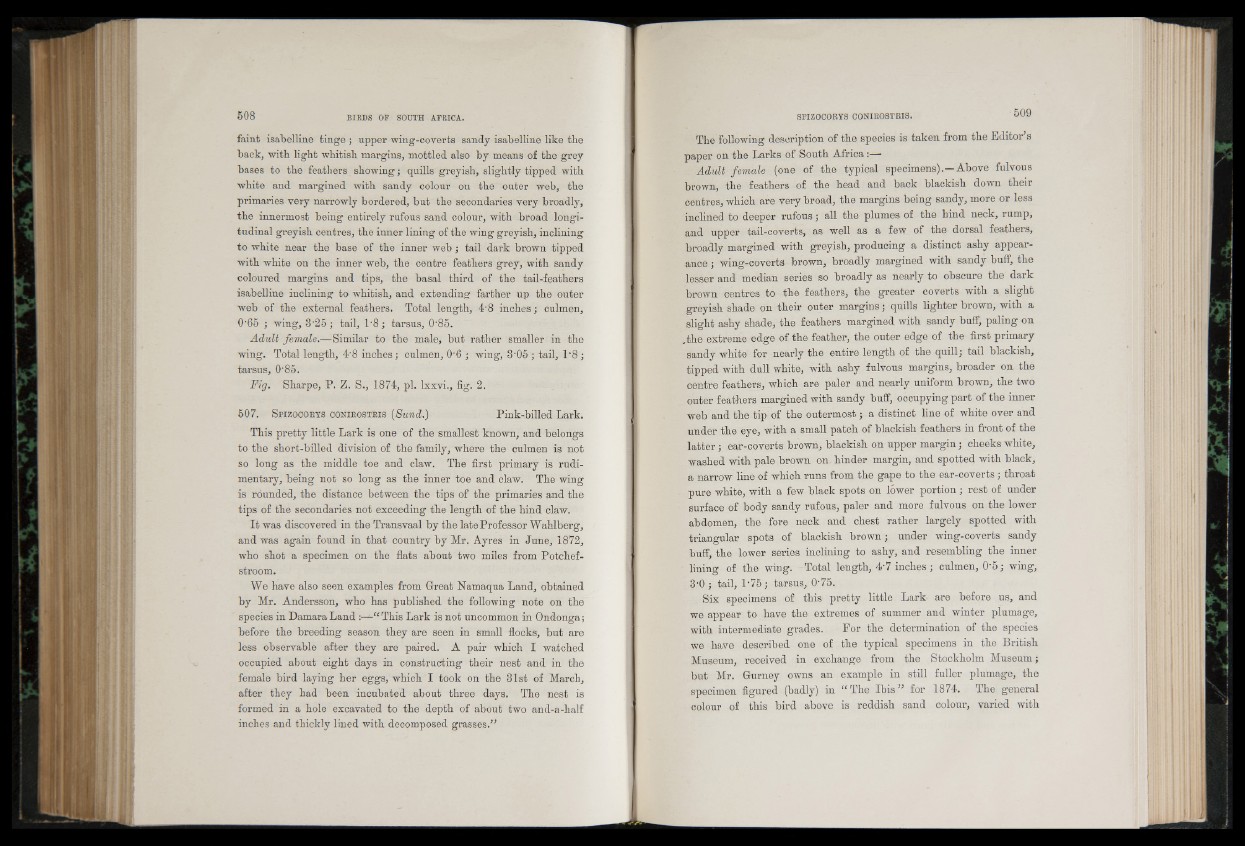
faint isabelline tinge ; upper wing-coverts sandy isabelline like the
back, with light whitish margins, mottled also by means of the grey
bases to the feathers showing; quills greyish, slightly tipped with
white and margined with sandy colour on the outer web, the
primaries very narrowly bordered, but the secondaries very broadly,
the innermost being entirely rufous sand colour, with broad longitudinal
greyish centres, the inner lining of the wing greyish, inclining
to white near the base of the inner web; tail dark brown tipped
with white on the inner web, the centre feathers grey, with sandy
coloured margins and tips, the basal third of the tail-feathers
isabelline inclining to whitish, and extending farther up the outer
web of the external feathers. Total length, 4'8 inches; culmen,
0'65 ; wing, 3'25; tail, T8; tarsus, 0-85.
Adult female.—Similar to the male, but rather smaller in the
wing. Total length, 4‘8 inches; culmen, 0'6 ; wing, 3'05 ; tail, T8 ;
tarsus, 0'85.
Fig. Sharpe, P. Z. S., 1874, pi. lxxvi., fig. 2.
507. S pizocorys conirostris (Sund.) Pink-billed Lark.
This pretty little Lark is one of the smallest known, and belongs
to the short-billed division of the family, where the culmen is not
so long as the middle toe and claw. The first primary is rudimentary,
being not so long as the inner toe and claw. The wing
is rounded, the distance between the tips of the primaries and the
tips of the secondaries not exceeding the length of the hind claw.
It was discovered in the Transvaal by the late Professor Wahlberg,
and was again found in that country by Mr. Ayres in June, 1872,
who shot a specimen on the flats about two miles from Potchef-
stroom.
We have also seen examples from Great Namaqua Land, obtained
by Mr. Andersson, who has published the following note on the
species in Damara Land This Lark is not uncommon in Ondonga;
before the breeding season they are seen in small flocks, but are
less observable after they are paired. A pair which I watched
occupied about eight days in constructing their nest and in the
female bird laying her eggs, which I took on the 31st of March,
after they had been incubated about three days. The nest is
formed in a hole excavated to the depth of about two and-a-half
inches and thickly lined with decomposed grasses.”
The following description of the species is taken from the Editor’s
paper on the Larks of South Africa:—
Adult female (one of the typical specimens).—Above fulvous
brown, the feathers of the head and back blackish down their
centres, which are very broad, the margins being sandy, more or less
inclined to deeper rufous; all the plumes of the hind neck, rump,
and upper tail-coverts, as well as a few of the dorsal feathers,
broadly margined with greyish, producing a distinct ashy appearance
; wing-coverts brown, broadly margined with sandy buff, the
lesser and median series so broadly as nearly to obscure the dark
brown centres to the feathers^ the greater coverts with a slight
greyish shade on their outer margins; quills lighter brown, with a
slight ashy shade, the feathers margined with sandy buff, paling on
,the extreme edge of the feather, the outer edge of the first primary
sandy white for nearly the entire length of the quill; tail blackish,
tipped with dull white, with ashy fulvous margins, broader on the
centre feathers, which are paler and nearly uniform brown, the two
outer feathers margined with sandy buff, occupying part of the inner
web and the tip of the outermost; a distinct line of white over and
under the eye, with a small patch of blackish feathers in front of the
latter; ea,r-coverts brown, blackish on upper margin; cheeks white,
washed with pale brown on. hinder margin, and spotted with black,
a narrow line of which runs from the gape to the ear-coverts; throat
pure white, with a few black spots on lower portion ; rest of under
surface of body sandy rufous, paler and more fulvous on the lower
abdomen, the fore neck and chest rather largely spotted with
triangular spots of blackish brown; under wing-coverts sandy
buff, the lower series inclining to ashy, and resembling the inner
lining of the wing. Total length, 4‘7 inches; culmen, 0 5 ; wing,
3-0; tail, l -75; tarsus, 075.
Six specimens of this pretty little Lark are before us, and
we appear to have the extremes of summer and winter plumage,
with intermediate grades. For the determination of the species
we have described one of the typical specimens in the British
Museum, received in exchange from the Stockholm Museum;
but Mr. Gurney owns an example in still fuller plumage, the
specimen figured (badly) in “ The Ibis” for 1874. The general
colour of this bird above is reddish sand colour, varied with